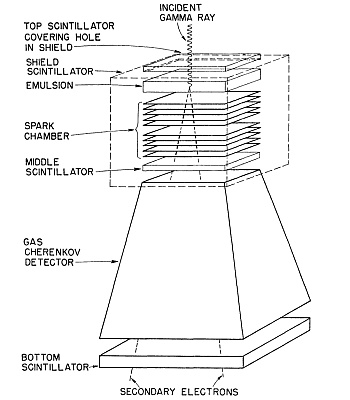Purpose of the flight and payload description
The objective of the flight was to launch a GAMMA-RAY TELESCOPE to measure high energy gamma rays from point sources in the sky. The telescope was developed at the School of Physics and Astronomy of the University of Minnesota, with support from both NASA and the U.S. Office of Naval Research.
The instrument which can be seen in the scheme at left (click to enlarge) consisted of a sophisticated array that combined nuclear emulsions with electronic detectors to achieve high angular resolution while maintaining detection efficiency.
The core component was a photographic nuclear emulsion block that served as the converter material, chosen specifically to achieve the highest possible angular resolution. Below this emulsion block, the instrument incorporated two thin-plate spark chambers, each with four gaps, which were designed to record the passage of electrons produced when gamma rays converted in the emulsion. The positioning of these chambers was critical for tracking the electron pairs with high precision.
The trigger and acceptance geometry of the system was defined by an array of electronic counters placed below the spark chambers. This array was composed of two scintillation counters separated by a specialized gas Cherenkov counter. The Cherenkov counter was 1 meter in length and contained nitrogen gas maintained at a pressure of 1 atmosphere, specifically configured to eliminate any particles with energies below 40 me².
For radiation shielding and background rejection, the emulsion block and spark chambers were completely surrounded by an anticoincidence scintillation counter. This shield featured a strategic opening in its top surface, positioned directly above the emulsion block, which was covered by an additional scintillation counter that was optically isolated from the main shield. This top counter was versatile in its operation, capable of working in either coincidence or anticoincidence mode, and was specifically designed for the detection of very high-energy multiply charged nuclei.
All these components, along with their associated electronics and power supplies, were housed within a pressurized gondola. The gondola was mounted within a frame using a fixed zenith angle configuration to enable orientation control during flight. For precise pointing and orientation, the system employed a flux-gate magnetometer that provided azimuthal orientation to either north or south. The orientation of the gondola was continuously tracked using two independent systems: a pair of moving-film cameras arranged perpendicularly that photographically recorded the position of Polaris, and a galvanometer record of the magnetometer output that was photographed simultaneously with each spark-chamber event.
This dual tracking system achieved remarkable precision, allowing the determination of true azimuthal orientation to within ±0.1° using the Polaris films and ±1° using the magnetometer galvanometer.
Details of the balloon flight
Balloon launched on: 12/13/1966 at 19:16 CST
Launch site: Columbia Scientific Balloon Facility, Palestine, Texas, US
Balloon launched by: NCAR National Scientific Balloon Flight Station
Balloon manufacturer/size/composition: Zero Pressure Balloon Winzen 10.600.000 cuft (0.5 Mil. Stratofilm)
Flight identification number: 272P
End of flight (L for landing time, W for last contact, otherwise termination time): 12/13/1966
Balloon flight duration (F: time at float only, otherwise total flight time in d:days / h:hours or m:minutes - ): 2 h
Landing site: In Montgomery, Alabama, US
Payload weight: 1060 lbs
Successful flight
The balloon was launched from the NCAR Balloon Flight Base in Palestine, Texas at 19:16 CST on December 13, 1966. The scientific experiment was considered to be successful, although balloon did not reacted positively to ballasting and never reached theoretical ceiling. The two (2) hour period noted for time at altitude represents the time during which the gondola was activated. Cutdown was executed early to avoid increasingly poor surface weather along the track. The payload was recovered in good condition in Montgomery, Alabama.
External references
- Balloon Flight Record Facilities for Atmospheric Research Nº 3 - Spring 1967
- NCAR Scientific Balloon Facility Annual Report, 1966 National Center for Atmospheric Research, January 1967
If you consider this website interesting or useful, you can help me to keep it up and running with a small donation to cover the operational costs. Just the equivalent of the price of a cup of coffee helps a lot.


